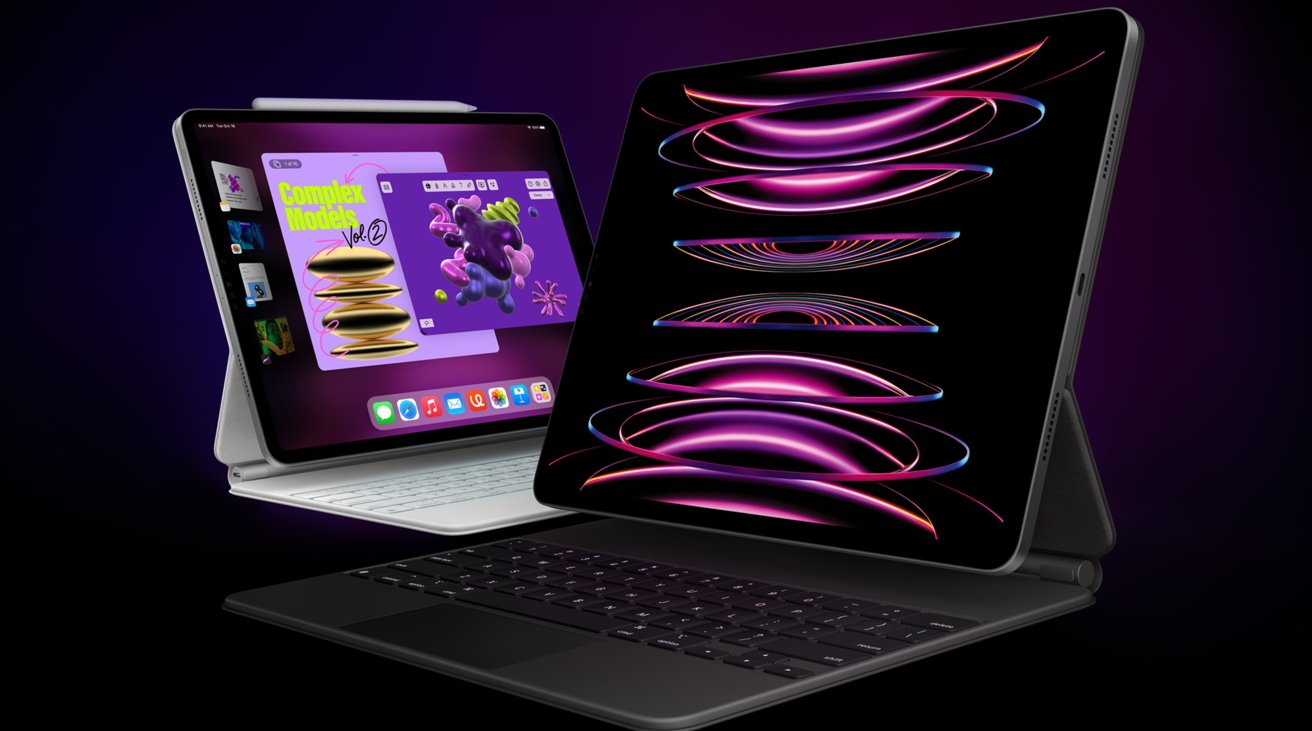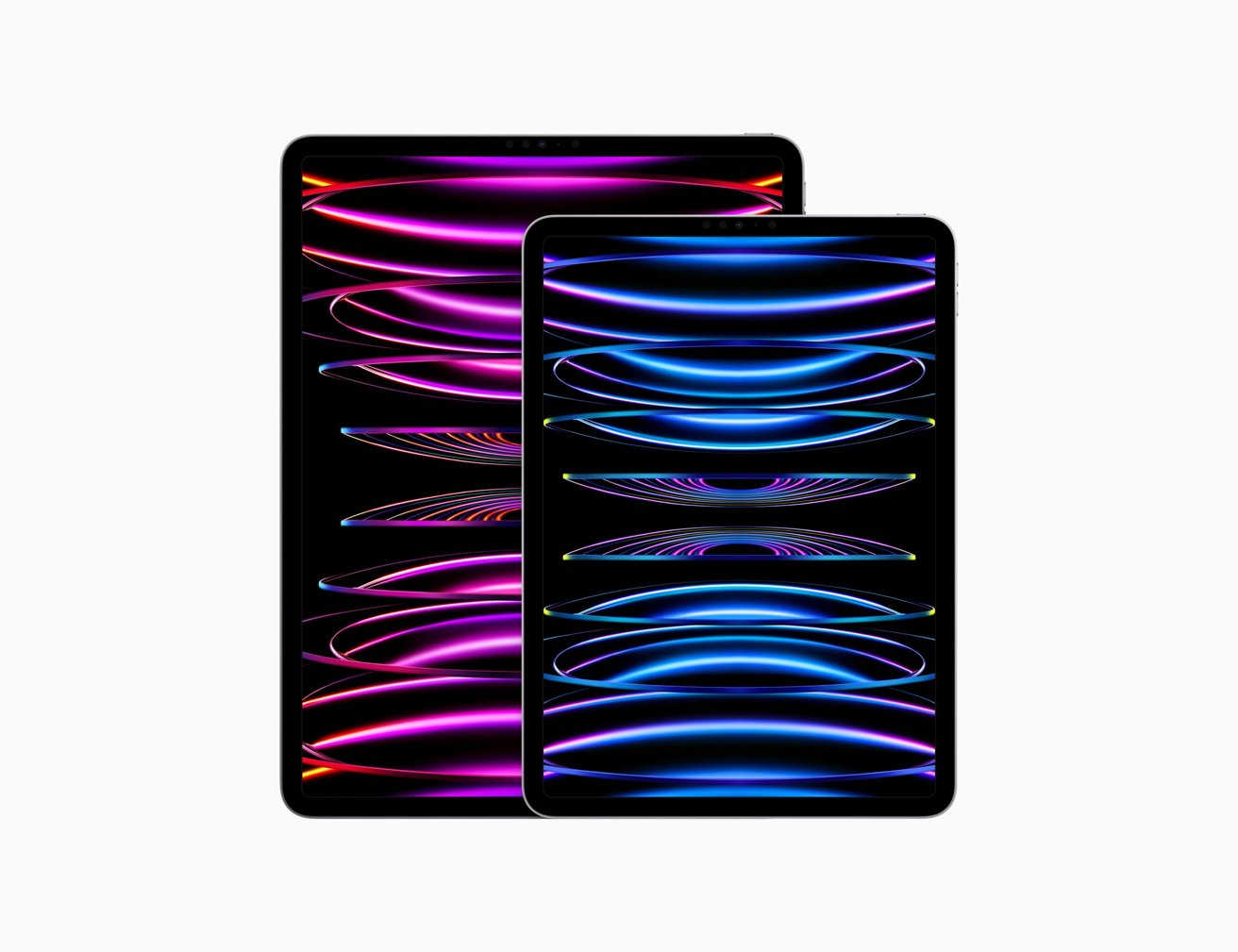Apple brings M2 to iPad Pro alongside Wi-Fi 6E
Apple has launched its refresh of the iPad Pro lineup, with the upgrade to the M2 chip adding Wi-Fi 6E support but not mini LED for the 11-inch model.
 12.9-inch iPad Pro with Magic Keyboards" />
12.9-inch iPad Pro with Magic Keyboards" />
11-inch and 12.9-inch iPad Pro with Magic Keyboards
Announced as part of Apple's October special event, the updated iPad Pro range is largely an internal spec bump, with the chief change to the premium tablets being the shift over from using the M1 chip to the M2.
The chip that has already been released in the MacBook Air and 13-inch MacBook Pro was an expected addition to the iPad Pro models. Along with the 8-core CPU and 10-core GPU, the chip brings with it the Media Engine, accelerating video encoding and decoding tasks.
The models still include either 8GB or 16GB of memory, depending on storage capacity. Storage continues to start from 128GB and rises through 256GB, 512GB, and 1TB to a maximum of 2TB.
One missing change is an update to the 11-inch iPad Pro display. While the 12.9-inch iPad Pro continues to use the Liquid Retina XDR Display with mini-LED backlighting, the change hasn't introduced it to the smaller model.

The 12.9-inch iPad Pro and the 11-inch iPad Pro for 2022.
The screens have 2,388 by 1,668 and 2,732 by 2,048-pixel resolutions respectively, and have support for ProMotion, Wide Color (P3), and True Tone. The second-generation Apple Pencil 2 is still supported by both tablets, but Apple now boasts the ability to detect the stylus tip up to 12mm away from the display.
Around the back, the camera system consists of two sensors, with a 12MP Wide accompanied by a 10MP Ultra Wide version. A 2x optical zoom out with a 5x digital zoom is offered, along with a True Tone flash, and LiDAR for depth mapping applications.
The front TrueDepth camera sports a 12-megapixel Ultra Wide camera, along with its usual depth mapping capabilities that it uses for Face ID, Animoji and Memoji, and Portrait mode shots.
The rear cameras can capture 4K footage at 60fps, complete with cinematic video stabilization, and a 240fps 1080p slo-mo mode. The TrueDepth camera can manage 1080p 60fps video with cinematic video stabilization.
For connectivity, Apple has upgraded the Wi-Fi to now support Wi-Fi 6E, enabling more bandwidth on networks supporting the standard. It has also been updated from Bluetooth 5.0 to Bluetooth 5.3, with continued options to upgrade to a Cellular model with 5G support in both sub-6GHz and mmWave varieties.
While the iPhone 14 is moving away from physical SIM cards, they're sticking around for a while on the iPad Pro. The cellular model in the U.S. has both eSIM and nano-SIM support.
The 11-inch iPad Pro starts from $799 for the Wi-Fi model, $999 for Wi-Fi + Cellular, while the 12.9-inch iPad Pro is priced from $1,099 and $1,299 respectively.
Pre-orders open today, with availability from October 26.
Read on AppleInsider
 12.9-inch iPad Pro with Magic Keyboards" />
12.9-inch iPad Pro with Magic Keyboards" />11-inch and 12.9-inch iPad Pro with Magic Keyboards
Announced as part of Apple's October special event, the updated iPad Pro range is largely an internal spec bump, with the chief change to the premium tablets being the shift over from using the M1 chip to the M2.
The chip that has already been released in the MacBook Air and 13-inch MacBook Pro was an expected addition to the iPad Pro models. Along with the 8-core CPU and 10-core GPU, the chip brings with it the Media Engine, accelerating video encoding and decoding tasks.
The models still include either 8GB or 16GB of memory, depending on storage capacity. Storage continues to start from 128GB and rises through 256GB, 512GB, and 1TB to a maximum of 2TB.
One missing change is an update to the 11-inch iPad Pro display. While the 12.9-inch iPad Pro continues to use the Liquid Retina XDR Display with mini-LED backlighting, the change hasn't introduced it to the smaller model.

The 12.9-inch iPad Pro and the 11-inch iPad Pro for 2022.
The screens have 2,388 by 1,668 and 2,732 by 2,048-pixel resolutions respectively, and have support for ProMotion, Wide Color (P3), and True Tone. The second-generation Apple Pencil 2 is still supported by both tablets, but Apple now boasts the ability to detect the stylus tip up to 12mm away from the display.
Around the back, the camera system consists of two sensors, with a 12MP Wide accompanied by a 10MP Ultra Wide version. A 2x optical zoom out with a 5x digital zoom is offered, along with a True Tone flash, and LiDAR for depth mapping applications.
The front TrueDepth camera sports a 12-megapixel Ultra Wide camera, along with its usual depth mapping capabilities that it uses for Face ID, Animoji and Memoji, and Portrait mode shots.
The rear cameras can capture 4K footage at 60fps, complete with cinematic video stabilization, and a 240fps 1080p slo-mo mode. The TrueDepth camera can manage 1080p 60fps video with cinematic video stabilization.
For connectivity, Apple has upgraded the Wi-Fi to now support Wi-Fi 6E, enabling more bandwidth on networks supporting the standard. It has also been updated from Bluetooth 5.0 to Bluetooth 5.3, with continued options to upgrade to a Cellular model with 5G support in both sub-6GHz and mmWave varieties.
While the iPhone 14 is moving away from physical SIM cards, they're sticking around for a while on the iPad Pro. The cellular model in the U.S. has both eSIM and nano-SIM support.
The 11-inch iPad Pro starts from $799 for the Wi-Fi model, $999 for Wi-Fi + Cellular, while the 12.9-inch iPad Pro is priced from $1,099 and $1,299 respectively.
Pre-orders open today, with availability from October 26.
Read on AppleInsider

Comments
About the old Pencil, that would require the new charging method which costs more than the port it uses now, which is there anyway. That’s the main reason, as Apple is trying to keep costs down for those models.
The Magic Keyboard Folio looks awesome! I've been wanting just the back half ever since the 2018 model. Hopefully some case makers will just make the back half for the iPad Pro models.
Oh, the continuous fight between product marketers, finance and engineers must be vicious. There is now 3 11" iPads: iPad 10th gen, iPad Air 5th gen and iPad Pro 4th gen. It's a rather fine line of segmentation between the 3. Display size is far and away the easiest way to segment. The iPad Pros need to increase in display size, like 12" and 14" to differentiate them again.
My money is earmarked for a iPP12.9 2TB 5G. My iPP10.5 is getting long in the tooth. There is a weird yellowing along the sides of the display now. Touch ID button is hitchy. It's been one of my favorite purchases.
Either way, the iPad 10th gen heralds a change in industrial design for the iPad Pro models in what, Spring of 2024? Cameras go on the long side. The Pencil magnetic charging will need to be moved or they have to cram both the front cams and the induction charger in basically the same space. I like them to round the bottom edges like the new Macbook's are. Oh, and make optional camera modules that are flush with the surface. I don't need a higher end back cam. Just something good enough to take pictures of forms, checks and stuff.
Hopefully they will open the spigots on the software. The larger the display size, the more that they have to open up the software. The operating system work moves slower than the hardware. It may be 5 years for apps to adjust for Stage Manager, for Apple to incrementally improve iPadOS UI features, so on and so forth. I don't think people will be missing much if they buy now.
If they are, there is always the sell/trade-in and buy cycle.